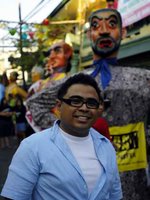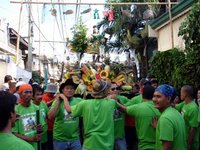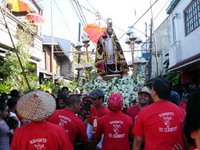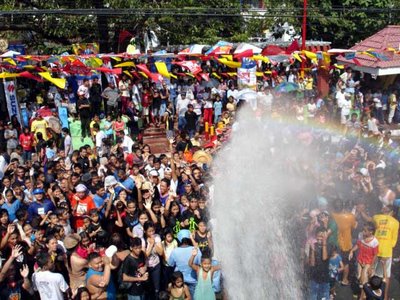
Today, I finally got to visit the town of
Angono, Rizal which is known as the
Art Capital of the Philippines and the hometown of two national artists namely Carlos "Botong" V. Francisco for painting and Lucio D. San Pedro for music. Our purpose was to check out the annual
Higantes Festival as well as the fluvial procession in honor of the town patron San Clemente held every November 23.
But what a way to start my day! Since on the way to Angono, I got to witness Philippine road courtesy at its worst! Despite the fact that it was still early in the morning, traffic was slow no thanks to the jeepneys who had virtually occupied all three lanes of the road to pick up passengers. Ironically, the shoulders and parking slots on the side of Sta. Lucia East for example was empty and available for use. If we phase out jeepneys from the streets and replace them with an efficient transport system, I could bet you we wouldn't have traffic since most of the grind is a result of undisciplined jeepney drivers and that is virtually all of them!

You had tricycles on the left as well as center lanes when these slow creatures should use the right lanes. In fact, the law does not allow them on national roads! They are being tolerated and yet they cruise along the busy metropolis streets as if there are no vehicles impatiently following behind them. You had vehicles creating their own counter-flows. Indeed, what a way to start my day!
But my excitement overtook my impatience and lack of sleep especially as we neared Angono. The access road to the town was blocked so we had to enter it through a side street. We were able to park in front of the town plaza. From there, it was a 1 kilometer walk to the church where the parade and procession was going to originate from. We arrived at the church just in time for the ending of the Mass and the beginning of the festivities in honor of San Clemente.

It was one big party on the streets of Angono as the loud and rambunctious mardi gras-like parade made its way around town. Of course, there were the
higantes, which are colorful paper mache giants measuring about ten to twelve feet in height.
I heard that
higantes used to be found in
fiesta celebrations around the country. One story of its origin traces back the roots of this practice to the Spanish colonial period. Hacienda owners were wary of expenses and thus prohibited all celebrations except for one annual fiesta. To make the best of a gloomy situation, the townsfolk borrowed an art form imported from Mexico by Spanish friars and created larger-than-life caricatures of their Spanish landlords, a sly joke to get back at them.

As Angono-based painter Nemiranda recounts, there used to be only two or three
higantes at the start of the procession. But because of the large number of artists, which at that time included Botong Francisco, Angono was not only able to maintain this practice. The town elevated it to an art form thanks to creativity of the many artists of the town who made their own versions of the
higantes.

But I would learn that the higantes are just one aspect of this merrymaking. Following them was the procession proper. But this was quite an unusual procession led by altar boys in shorts and rowdy revelers following close behind. Expect to get wet since water is flying all over the place as participants chant
"Tubig! Tubig!" asking the people around to throw water at them. Just pray that you don't get hit by a water gun of some wise guy who gets his supply of water from the canal along the street.
The bulk of the procession was composed of
parehadoras, groups of young girls from every barangay, in colorful costumes, wearing wooden slippers
(bakya), and each holding a wooden boat paddle
(sagwan), marching together and stomping the ground in a uniform beat as they walked around town followed by a marching band.

And there were various groups of townsfolk in themed spoofs of pop culture icons. I wonder how Kris Aquino would react if she saw who spoofed her and the 26K. Haha! Towards the end of the procession were the
andas bearing three images. The first was that of San Isidro Labrador. A little further back was that of the town patron San Clemente escorted by the Knights of St. Clement in red t-shirts. And at the end of the procession was the image of the Virgin Mary escorted by a bevy of young girls in white dresses. Bamboo pole-bars with hanging ornaments were installed along the route. These were raised by levers on either side as an image passed under it.

We met up again with the parade at the town plaza where it slowed down as louder chants of
"Tubig! Tubig!" could be heard, with the crowd summoning the operators of a water truck from Manila Water to hose them down and drench them wet! Everyone wanted his or her share of the water as if it were manna from Heaven.

But the activities did not end there. The images still had to be brought to the banks of the Laguna de Bay where they would be enshrined in a floating pagoda for a fluvial procession. We decided to take a tricycle going there since it was still a distance away. The pagoda was a simple tent constructed from bamboo. As the last image was brought on board, the pagoda set sail.
We didn't finish the entire procession since we wanted to visit the Angono Petroglyphs. On the way back to the plaza, we saw the Blanco Family Museum but since we were on a tricycle, we couldn't stop.

We got my car and tried to ask around for the petroglyphs. Everyone we asked from the tricycle drivers, the traffic enforcers to the car wash attendants (my car was full of mud so I had it cleaned) had this puzzled look on their faces when we asked about the petroglyphs. Ordinary people in Angono do not know that they have a national cultural treasure in their town. And there were no signages along the main roads pointing to it either!
Part 2:
Angono is the Art Capital of the PhilippinesPart 3:
Angono Petroglyphs in Binangonan, Rizal
 Since Angono was small anyway, we decided to try our luck and drove towards the hills since that would be the best place to look for them. We made a turn towards the Eastridge Golf and Country Club and saw a sign pointing to the Nemiranda Family Museum. Now this is something I wanted to see having heard of the artist from television features to newspaper and magazine articles.
Since Angono was small anyway, we decided to try our luck and drove towards the hills since that would be the best place to look for them. We made a turn towards the Eastridge Golf and Country Club and saw a sign pointing to the Nemiranda Family Museum. Now this is something I wanted to see having heard of the artist from television features to newspaper and magazine articles. We had a nice chat about his place and how Angono transformed itself into the Art Capital of the Philippines. There are so many art galleries in the town such as his, Blanco Family, Vicente Reyes, Orville DR Tiamson, Ang Nuno, etc. I also asked him about the higantes and its history. He also shared with us his experiences with Botong Francisco, how his father and Botong were very good friends and how he could have been the last artist to talk with Botong before he passed away since they chatted (Miranda was a junior college student then) on the morning the very day Botong died.
We had a nice chat about his place and how Angono transformed itself into the Art Capital of the Philippines. There are so many art galleries in the town such as his, Blanco Family, Vicente Reyes, Orville DR Tiamson, Ang Nuno, etc. I also asked him about the higantes and its history. He also shared with us his experiences with Botong Francisco, how his father and Botong were very good friends and how he could have been the last artist to talk with Botong before he passed away since they chatted (Miranda was a junior college student then) on the morning the very day Botong died.










